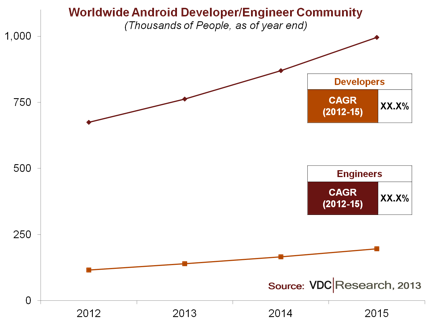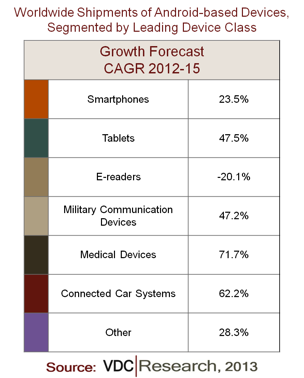Over the past few years, Android has come to dominate the market shares of smartphone and tablet operating systems. Now, the operating system can be seen making inroads into new industries and device types.
As of August, Android controlled more than 79% of the smartphone market and more than 62% of the tablet market, according to research by International Data Corp.
Meanwhile, a new study by VDC Research projected that Android device sales will eclipse 900 million a year by 2015, spurred by market-share increases not only in smartphones and tablets, but also through integration into medical devices, connected car systems and military communications devices, among other applications.
(Getting software into cars: Ford releases OpenXC, an open-source API for automobiles)
“Android has really emerged quite rapidly, as the fastest-growing operating systems of all the verticals we track,” said Christopher Rommel, vice president of machine-to-machine (M2M) and embedded technology at VDC Research.
VDC conducted a survey of 500 engineers and developers working on Android projects. The survey asked about current and future projects, the growing role of the application developer community, and which vendors are expanding into M2M and embedded systems. VDC’s research also incorporated project information from vendors, including companies like Intel, Microsoft, Samsung, Siemens, Sony and Wind River.

VDC research showed that one of Android’s biggest growth areas by 2015 will be in connected car systems, forecasted to grow by more than 62% over the next three years. The boom is fueled in part by initiatives such as the GSM Association’s Connected Car Forum, which is helping the connected car market grow through automakers and mobile operators working to improve the speed and quality of telematics and infotainment services. The research showed that Android will gain ground on other OSes competing for car OEMs, based on the ability to upgrade outdated OEMs of older vehicles with technology on par with smartphone and tablet capabilities.
#!
Android is already taking hold in aftermarket systems like the Kenwood DNN990HD connected navigation system and the Clarion AX1 car stereo system, based on Wind River technology. At the moment, Windows Embedded Automotive, QNX Car Platform, and GENIVI-compliant solutions have a leg up on Android, but QNX is hurt by the plummeting value of BlackBerry and, research points to Android making big gains in automotive OEMs, according to Rommel.
(FBI: Seventy-nine percent of mobile malware attacks are directed at Android)
An even bigger projected growth area for Android operating systems is the medical device market, with a predicted 71% spike by 2015. Embedded virtualization vendors surveyed cited medical devices as a prime use case for multi-OS systems, with a real-time operating system controlling any critical functionality while Android powers the user interface. While the healthcare industry is reluctant to redesign legacy systems to include Android, research pointed to consumer-centric uses for Android in patient entertainment systems and exercise equipment.
The chart below shows VDC’s growth forecast for Android’s operating system in the next three years.

Security concerns hampered Android’s earlier attempts at expanding into these markets, but VDC’s research showed that companies such as Wind River have augmented Android’s security to deploy the software safely. Wind River Solution Accelerators can run virtualization hypervisors to control the Android user interface and connectivity, while running real-time operating systems to control apps with safety-critical implications.






